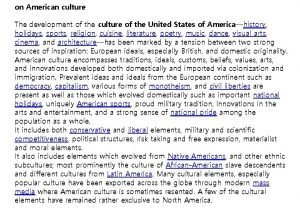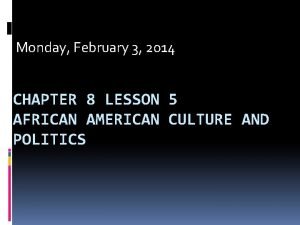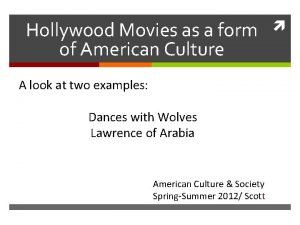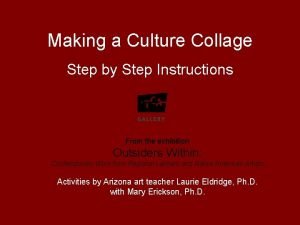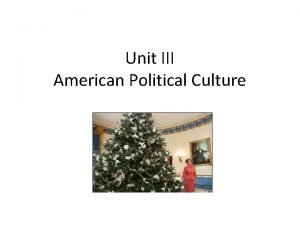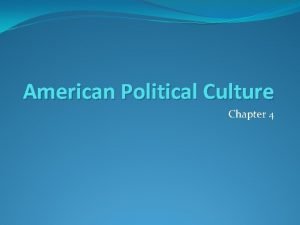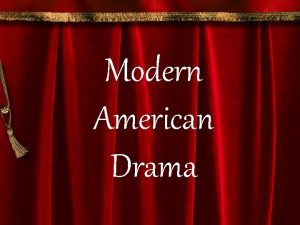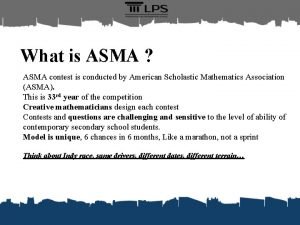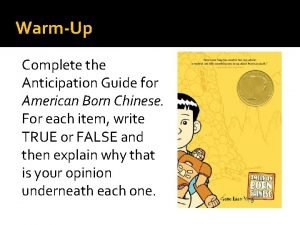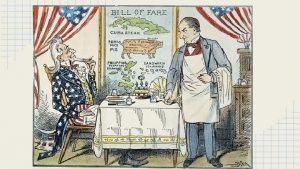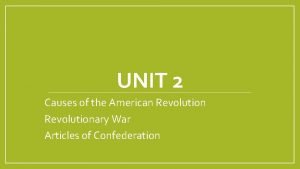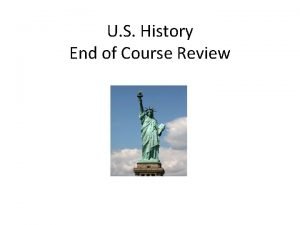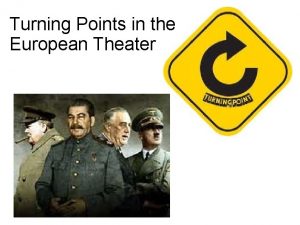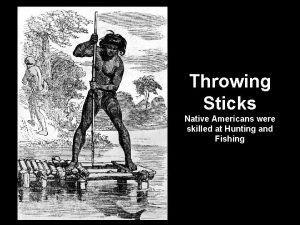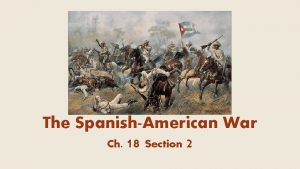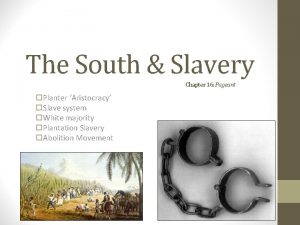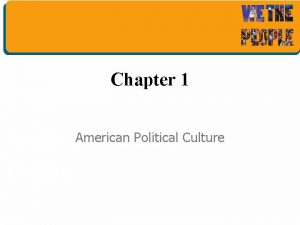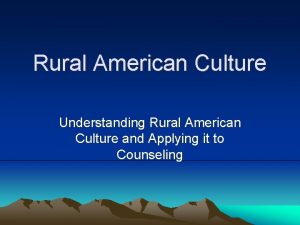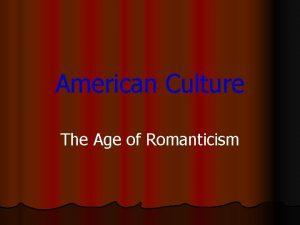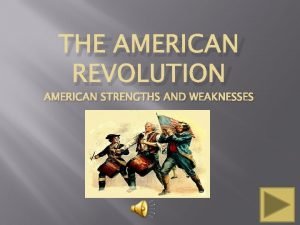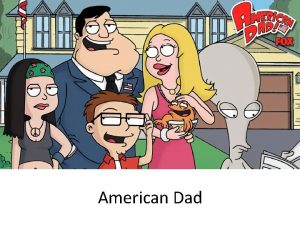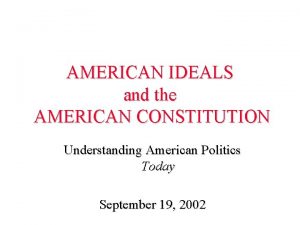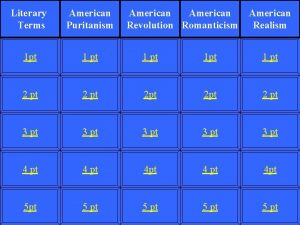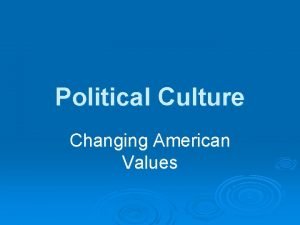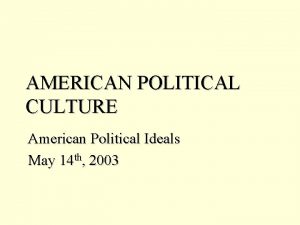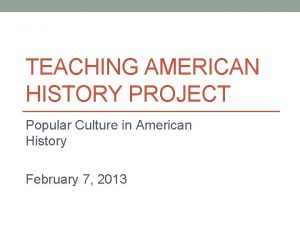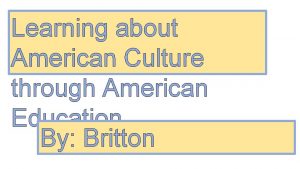on American culture The development of the culture


![[edit] Religion Main article: Religion in the United States Completed in 1716, Mission Nuestra [edit] Religion Main article: Religion in the United States Completed in 1716, Mission Nuestra](https://slidetodoc.com/presentation_image_h/0e65b922c4ee8b5aff0d3a67eb4eddc7/image-3.jpg)


![[edit] National holidays Fireworks light up the sky over the Washington Monument. Americans traditionally [edit] National holidays Fireworks light up the sky over the Washington Monument. Americans traditionally](https://slidetodoc.com/presentation_image_h/0e65b922c4ee8b5aff0d3a67eb4eddc7/image-6.jpg)




















































































- Slides: 90

on American culture The development of the culture of the United States of America—history, holidays, sports, religion, cuisine, literature, poetry, music, dance, visual arts, cinema, and architecture—has been marked by a tension between two strong sources of inspiration: European ideals, especially British, and domestic originality. American culture encompasses traditions, ideals, customs, beliefs, values, arts, and innovations developed both domestically and imported via colonization and immigration. Prevalent ideas and ideals from the European continent such as democracy, capitalism, various forms of monotheism, and civil liberties are present as well as those which evolved domestically such as important national holidays, uniquely American sports, proud military tradition, innovations in the arts and entertainment, and a strong sense of national pride among the population as a whole. It includes both conservative and liberal elements, military and scientific competitiveness, political structures, risk taking and free expression, materialist and moral elements. It also includes elements which evolved from Native Americans, and other ethnic subcultures; most prominently the culture of African-American slave descendents and different cultures from Latin America. Many cultural elements, especially popular culture have been exported across the globe through modern mass media where American culture is sometimes resented. A few of the cultural elements have remained rather exclusive to North America.

Mark Twain is regarded as among the greatest writers in American history. Main article: Literature of the United States In the eighteenth and early nineteenth centuries, American art and literature took most of its cues from Europe. During its early history, America was a series of British colonies on the eastern coast of the present-day United States. Therefore, its literary tradition begins as linked to the broader tradition of English literature. However, unique American characteristics and the breadth of its production usually now cause it to be considered a separate path and tradition. Writers such as Nathaniel Hawthorne, Edgar Allan Poe, and Henry David Thoreau established a distinctive American literary voice by the middle of the nineteenth century. Mark Twain and poet Walt Whitman were major figures in the century's second half; Emily Dickinson, virtually unknown during her lifetime, would be recognized as America's other essential poet. Eleven U. S. citizens have won the Nobel Prize in Literature, most recently Toni Morrison in 1993. Ernest Hemingway, the 1954 Nobel laureate, is often named as one of the most influential writers of the twentieth century. [1] A work seen as capturing fundamental aspects of the national experience and character—such as Herman Melville's Moby-Dick (1851), Twain's The Adventures of Huckleberry Finn (1885), and F. Scott Fitzgerald's The Great Gatsby (1925)—may be dubbed the "Great American Novel". Popular literary genres such as the Western and hardboiled crime fiction were developed in the United States.
![edit Religion Main article Religion in the United States Completed in 1716 Mission Nuestra [edit] Religion Main article: Religion in the United States Completed in 1716, Mission Nuestra](https://slidetodoc.com/presentation_image_h/0e65b922c4ee8b5aff0d3a67eb4eddc7/image-3.jpg)
[edit] Religion Main article: Religion in the United States Completed in 1716, Mission Nuestra Señora de la Purísima Concepción de Acuña is one of numerous surviving colonial Spanish missions in the United States. These were primarily used to convert the Native Americans to Roman Catholicism. Surrounded by sleek modern skyscrapers, Saint Patrick's Cathedral stands as the last old world holdout of New York's Rockefeller Plaza

Among developed countries, the US is one of the most religious in terms of its demographics. According to a 2002 study by the Pew Global Attitudes Project, the US was the only developed nation in the survey where a majority of citizens reported that religion played a "very important" role in their lives, an attitude similar to that found in its neighbors in Latin America. [2] Several of the original Thirteen Colonies were established by English and Irish settlers who wished to practice their own religion without discrimination or persecution as religious extremists in Europe: Pennsylvania was established by Quakers, Maryland by Roman Catholics and the Massachusetts Bay Colony by Puritans. Nine of the thirteen colonies had official public religions. Yet by the time of the Philadelphia Convention of 1787, the United States became one of the first countries in the world to enact freedom of religion by way of a codified separation of church and state. Modeling the provisions concerning religion within the Virginia Statute for Religious Freedom, the framers of the United States Constitution rejected any religious test for office, and the First Amendment specifically denied the central government any power to enact any law respecting either an establishment of religion, or prohibiting its free exercise. In following decades, the animating spirit behind the constitution's Establishment Clause led to the disestablishment of the official religions within the member states. The framers were mainly influenced by secular, Enlightenment ideals,

But they also considered the pragmatic concerns of minority religious groups who did not want to be under the power or influence of a state religion that did not represent them. [3] Thomas Jefferson, author of the Declaration of Independence said "The priest has been hostile to liberty. He is always in alliance with the despot. "[4] [edit] Religious statistics for the United States It should be noted the following information is an estimation as actual statistics constantly vary. According to the CIA, [5] the following is the percentage of followers of different religions in the United States: • Christian: (78. 5%) • Protestant (51. 3%) • Roman Catholic (23. 9%) • Mormon (1. 7%) • Orthodox (1. 6%) • Jewish (1. 7%) • Buddhist (0. 7%) • Muslim (0. 6%) • Atheist/Agnostic (4%) • Other/Unspecified (14. 6%)
![edit National holidays Fireworks light up the sky over the Washington Monument Americans traditionally [edit] National holidays Fireworks light up the sky over the Washington Monument. Americans traditionally](https://slidetodoc.com/presentation_image_h/0e65b922c4ee8b5aff0d3a67eb4eddc7/image-6.jpg)
[edit] National holidays Fireworks light up the sky over the Washington Monument. Americans traditionally shoot fireworks throughout the night on the Fourth of July. Martin Luther King Day memorializes the legacy of Dr. King, who is widely regarded as the Patriarch of the Civil Rights Movement. Dr. King is pictured above delivering his "I Have a Dream" speech.

Inauguration Day is the only Federal holiday that is not annual but rather occurs only once every four years. The day begins with the inaguaration ceremony and ends with a military parade. Halloween is a widely observed tradition in the United States. It typically involves dressing up in costumes and an emphasis on the bizarre and frightening. The Macy's Thanksgiving Day Parade is attended by over 2. 5 million people each year. It is the largest organized festivity in the United States and is viewed by more Americans each year than any other holiday celebration. [6]

Today, Thanksgiving is generally celebrated as a family reunion with a large afternoon feast. European colonization has led to many traditional Christian holidays such as Easter, Lent, St. Patrick’s Day, and Christmas to be widely observed albeit they are celebrated in a secular manner by many people today. Independence Day (colloquially known as the Fourth of July) celebrates the anniversary of the country’s Declaration of Independence from the Kingdom of Great Britain. It is generally observed by parades throughout the day and the shooting of fireworks at night. Halloween is thought to have evolved from the ancient celtic festival of Samhain which was introduced in the American colonies by Irish settlers. It has become a holiday that is widely celebrated by children and teens who traditionally dress up in costumes and go door to door saying the words “Trick or Treat” in exchange for candy. It also brings about an emphasis on eerie and frightening urban legends and movies. The popularity of celebrating Halloween has become continusly popular among university students in the US. Both University of Wisconsin-Madison and Ohio University in Athens, Ohio are known across the US for their Halloween street fairs.

Additionally, Mardi Gras, which evolved from the Catholic tradition of Carnival, is observed notably in New Orleans, St. Louis, and Mobile, AL as well as numerous other towns. Texas still observes the anniversary of its Independence Day from Mexico. Federally recognized holidays are as follows: Date Official Name January 1 New Year's Day Third Monday in January Birthday of Martin Luther King, Jr. , or Martin Luther King, Jr. Day January 20, the first January 20 following a Presidential election Inauguration Day Third Monday in February Washington's Birthday Last Monday in May Memorial Day July 4 Independence Day First Monday in September Labor Day Second Monday in October Columbus Day November 11 Veterans Day Fourth Thursday in November Thanksgiving Day December 25 Christmas

P. 4 Discussion Points ․ Over the years, did many people immigrate to your country? Are there many immigrants today? Where are the immigrants from? Why did they leave their countries? ․ Did many people emigrate from your country to other countries? What are some of the countries they went to ? Did many people go to the United States? If so, do you know if there was a particular period when they went and a particular region where they settled? ․ What do "melting pot" and "mosaic" refer to? What do you think are some of the advantages and disadvantages of each? P. 6 Discussion Points ․ How many main political parties does your country have? Are there clear differences between the parties?

․ What are some of the bad effects of a low voter turnout? What can be done to increase voter turnout? In your country, is voter turnout high or low? P. 7 Discussion Points ․ What are some of the major imports and exports of your country? ․ The passage says that in the United States two major economic challenges are (1) increasing productivity of workers and (2) training workers for new kinds of jobs. Do you know what major economic challenges your country is facing now?

영미문화 discussion topics Topics for discussion (On American Values and Assumptions) Choose one of these topics to discuss (work in small groups) 1) Please describe the differences between values and assumptions. 2) What are the main values in America? Are these similar to those of our country? (p 19) 3) How does my country view the United States? Americans have been accused of believing that their country is better or more important than any other. Do you think the United States is more important? Explain. 4) This book describes Americans as "optimistic. " Are you (Koreans) basically optimistic about the future? Why or why not? 5) The most important value in America is individualism. Do you think individualism has only positive aspects? Or if you do not think so, please explain why?

6) Americans' attitudes about privacy can be difficult foreigners to understand. Please give some examples. 7) Please describe the concepts of “equality” that Americans believe. They have a deep faith that everyone is equal, but they make distinctions among themselves as a result of such factors as gender, age, wealth, or social position. Give some examples for these differences. 8) Relationships between students, teachers, and coworkers in American society are very informal. Please illustrate some examples (see p. 30) 9) Please introduce some examples of "goodness of humanity" (pp. 33 -34) 10) For Americans, time is a resource that, like water or coal, can be used well or poorly. "Time is money. " "Americans are seen by foreign visitors as automatons, unhuman creates who are so tied to their clocks. . " Do you agree with this opinion? If you think there are different concepts on time between Americans and Koreans, please illustrate the difference.

After reading the chapter of American Values and Assumptions Reading Journal In your journal, write about one of the following topics. 1. Explain what a visitor to your country should know in order to avoid intercultural misunderstandings. 2. Describe an experience you had in a foreign country or culture that helped you understand it better. 3. Choose a topic of your own related to the reading. One of the most important skills you can develop as a good reader is the ability to recognize the main idea in a piece of writing. Although writers often include many ideas, there is usually a central point, or message, they wish to convey. When you read something, you should ask yourself the following questions: What main idea is the writer trying to communicate? * How does the main idea relate to other ideas in the reading? How does the writer develop his or her main point? What does the writer want me to remember about this subject?

Ch. 2 The Communicative Style of Americans 1) When they first encounter another person, Americans engage in a kind of conversation they call ( ). What kinds of ( ) they do enjoy? (see p. 47) 2) Explain the difference in the favorite topics between Americans and other countries? (p. 48, second paragraph from the bottom) 3) What are the favorite forms of interaction? Illustrate the four forms in detail. (pp. 50 -51) 4) Americans often relate to each other as occupants of roles rather than as whole person. 이것의 예는? 이 문장의 의미는? (p. 54) 5) To conclude from their relatively limited verbal abilities that they are unintelligent is to underestimate them. (p. 54) 이 문장의 의미는?

6) Americans' preference for verbal over nonverbal means of communicating pertains also to the written word. ( ) are important to Americans. Explain about this sentence. (56 -57) 7) Body Movements and Gestures 에 있어 Americans 와 other country people 사이 차이점에 대해서 작가가 든 예 중에서 두개만 설명해 봅시다(59 -60). 8) What is an especially complex, subtle, and important aspect of nonverbal behavior? "Americans are trained to distrust people who do not "look them in the eye" when speaking to them. " Explain about Americans' eye contact (62). 9) “It is amusing to watch a conversation between an American and someone from a culture where habits concerning "conversational distance" are different. ” Please provide some examples that the writer gives about "converational distance. " (63)

American Communication Styles The USA The desire to debate issues directly leads Americans to be seen by some cultures as aggressive Cultural Compatibility How compatible are you? Get your own personalised compatibility report. 35 Countries >> Communication styles in business in the States are determined by many of the approaches to business we have already described above. The desire to debate issues directly and openly leads Americans to be seen by some cultures as aggressive and even rude. Coded speech and verbosity is often seen as time wasting and in time pressured corporate USA, that is a crime.

Thus, when an impasse is reached in meeting situations, the reaction is often to address it directly and ‘with feeling. ’ This direct, robust debate can often be viewed by more harmony seeking cultures as signalling the breakdown of meaningful discussions and as the signal to try to abandon the interaction - whereas in the States it is seen positively and as a sign of definite progress. Paradoxically, on first introductions, American seem very friendly, polite and solicitous of your well being which seems to be at odds with the verbal behaviour exhibited half an hour later in the meeting. This overt friendliness (Have nice day!, Hi, how are you doing? etc. ) should be taken for what it is — part of the protocol of the language and not as an attempt at establishing a life long friendship. Although coded speech and over-verbosity are frowned upon, the latest ‘management speak’ is often to the fore in business dealings which can make Americans sound extremely jargonistic — almost to the point of obscuring the real message. Americans are much more open in conversation about private affairs than many European cultures and the converse of this is that Americans will often, quite naively, ask very personal questions at an early stage in a relationship which may be perceived by some people as intrusive. (‘What do you make? )

• Education in the United States is highly decentralised with funding and curriculum decisions taking place mostly at the local level through school boards. Educational standards are generally set by state agencies. The Federal government through the United States Department of Education is involved with funding programs. School Grades Primary education and secondary education in the United States together are sometimes referred to as K-12 (kindergarten through twelfth grade). It should be noted that practice can vary from this general picture. Level / Grade, Age (Years old) • Pre-School, Nursery School, or Head Start; Under 5 • Elementary School In the nineteenth and early twentieth century, Elementary School or Grammar School included grades one through eight, high school included grades nine through twelve. • Kindergarten 5 -6 • 1 st Grade 6 -7 • 2 nd Grade 7 -8

• 3 rd Grade 8 -9 • 4 th Grade 9 -10 • 5 th Grade 10 -11 • Middle school (also called Junior High School) • 6 th Grade 11 -12 (not always. Some Elementary Schools include 6 th grade as their highest grade. ) • 7 th Grade 12 -13 • 8 th Grade 13 -14 • High school • 9 th Grade (Freshman year) 14 -15 • 10 th Grade (Sophomore year) 15 -16 • 11 th Grade (Junior year) 16 -17 • 12 th Grade (Senior year) 17 -18 "Middle school" or "Junior high school" may refer to schools that begin in 7 th grade and end in either 8 th or 9 th grade, where 6 th grade is the final grade in elementary school, and in the case ending in 9 th grade, only grades 10, 11, and 12 are in high school. The term "junior high school" and the arrangement beginning with 7 th grade is now much less common.

"High school" runs from grades 9 through 12. • College or University Undergraduate grades are also called Freshman, Sophomore, Junior, and Senior years. • Undergraduate • College or university • Four years leading to a a Bachelor or Arts (BA) or a Bachelor of Science (BS) degree. • Community college • Lower division, two years leading to an Associate of Arts (AA) degree. • Upper division, two years leading to B. A. or B. S. • Postgraduate • One to three years leading to a Master of Arts (MA) or Master of Science (MS) degree. • Four or more years leading to a Doctor of Philosophy (Ph. D) degree or two or more years after earning a Masters.

Contemporary issues in the United States Major educational issues in the United States center on curriculum, funding, and control. Curriculum issues • What type of school works best. • How to teach reading: phonics vs. whole language • Evolution: whether to teach evolution as a historical truth, or simply present evidence and how it supports various theories. • sex education: how much to teach about sexual intercourse, and at what age; is purpose to reduce disease and out-of-wedlock pregnancy, or what? • "Diversity" and hate speech: to what extent may students be required to tolerate or even approve of repugnant people and practices? • Dumbing down of curriculum: high school graduates often at 6 th to 8 th grade levels in 3 R's.

Funding Each state government provides free schools for residents, funded by taxes (often on real estate). • Vouchers: have voucher programs helped students learn better? Or do they damage public education? What are the trends? • Spending: is there any correlation between per-pupil spending and student achievement? • Class size: does hiring more teachers to reduce the teacherstudent ratio have any correlation with student achievement? • Current trends in US: building more prisons than schools. Samuel Clemens' thoughts on the matter: Every time you stop a school, you will have to build a jail. What you gain at one end you lose at the other. It's like feeding a dog on his own tail. It won't fatten the dog. - Speech 11/23/1900 At the college and university level, funding becomes a major tangle, as the US Government offers partial subsidies for education at accredited universities through federal financial aid and student loans. However, there is very little standardization as to how funding can be applied, often leading to a great deal of confusion regarding what steps to take.

Control • Who's responsible for a child's education? • Who decides curriculum contents: what should be mandatory, what should be forbidden? There are some facts. In U. S. law parents have the ultimate responsibility for, and authority over their children's education. The crucial tests of this legal doctrine occurred in attempts to sue public school officials for malpractice, in cases where, for example, illiterate young people graduated from highschool. The U. S. Supreme Court (Wisconsin v. Yoder, 406 U. S. 205 (1972)) defined the proper goal for education as "literacy and self-sufficiency, " that is, an educated, not a socialized child was recognized as the essential goal for the U. S. 's democratic republic. This decision is now interpreted as court recognition that parents have a fundamental right to choose the method to achieve literacy and self-sufficiency, that is to educate their children.

History Expansion of American education during the late 1800 s In 1870, only 2% of 17 year olds graduated from high school. By 1900, however, 31 states required 8 -14 year olds to attend school. As a result, by 1910, 72 percent of American children attended school and half of the nation's children attended one-room schools. Lessons consisted of students reading aloud from their texts such as the Mc. Guffey Readers, and emphasis was placed on rote memorization. Teachers often used physical punishments, such as hitting students on the knuckles with birch switches, for incorrect answers. Because the public schools focused on assimilation, many immigrants, who resisted Americanization, sent their children to private religious schoools. Higher Education Between 1880 and 1885, more than 150 new colleges and universities were opened in America. Philantrhopists endowed these institutions. Leland Stanford, one of The Big Four, for example, established Stanford University in 1885.

A Clean, Well-Lighted Place, by Hemingway Plot Summary The story begins at a cafe very late at night. Two waiters are watching their last, lingering customer, an old man who is by now very drunk. These are the story’s three major characters. The older of the two waiters informs the young one that the old man tried to commit suicide the previous week. They then watch a couple go by, a soldier and a young woman, and comment on the soldier’s chances of going undetected after curfew. Next, the young waiter moves into action. When the old man indicates that he wants another drink served, the young waiter mutinies. He decides he wants to go home, regardless of an unspoken rule that dictates he not go until the last customer voluntarily leaves. He pretends not to know what the old man wants. The old man realizes that the younger waiter is being offensive, but ignores him and asks out loud for the drink. When the waiter brings it, he makes it spill deliberately. Moreover, knowing that the old man is deaf, as he walks away he says, “You should have killed yourself last week. ” With these actions, the character of the young waiter is established. The two waiters then have a number of conversations about the old man and his suicide and situation. These talks are interrupted by the younger waiter finally telling the old man to leave, which he does. We learn various

facts from these interchanges. For example, the young waiter is “all confidence, ” he is married, he has a job, he is content with life and has little pity for those who are not content. He defends his actions (being churlish and making the old man leave): a cafe is not an all-night venue; if the old man were considerate he would let the waiters go home to their beds; there are bars and bodegas for people wanting to stay out late. The older waiter resembles the old man: he is lonely and he lives alone with no wife. He is an insomniac. He insists that special deference is due the old man because of his recent suicide attempt. Once the cafe is tidied and locked, the two waiters part amicably enough. The reader now finishes out this very short story with the older waiter. He does not go straight home. He thinks how he completely understands the old man’s desire to linger at a cafe, because the ambiance of a cafe is entirely different from that of a bar or bodega. He ends up, however, at a bar. All the cafes are, after all, closed. The old waiter looks at the bar where he stands and points out to the barman that his venue is well-lighted, but not clean: “The light is very pleasant but the bar is unpolished. ” The barman ignores the waiter. The waiter does not stay for a second drink. Apparently, he now feels strong enough to go home to his insomnia: “He disliked bars and bodegas. A clean, well-lighted cafe was a very different thing. Now, without thinking further, he went home to his room. He would lie in the bed

and finally, with daylight, he would go to sleep. After all, he said to himself, it is probably only insomnia. Many must have it. ” Themes Solidarity One of the most touching aspects of this short story is the older waiter’s expressed solidarity with the old man. While the young waiter is all “youth” and “confidence, ” the old waiter and the old man seem overwhelmingly lonely and tired-out by life. This communality structures the older waiter’s consistent thoughts of solidarity with the old man. He understands and defends him; he too prefers a clean, well-lighted cafe to a bar or bodega; he too seeks out such a place to forestall his own despair that night. The climax of this theme of solidarity is the climax of the story itself. It comes in its final line: “He disliked bars and bodegas. A clean, well-lighted cafe was a very different thing. Now, without thinking further, he went home to his room. He would lie in the bed and finally, with daylight, he would go to sleep. After all, he said to himself, it is probably only insomnia. Many must have it. ” It is the “many” of the final sentence of the story with which the story is concerned. Against the singular and selfish young waiter, the coupled old men signify the group or community that hangs together out of loyalty and a sense of

common cause. Hemingway’s fiction around the time of “A Clean, Well. Lighted Place” frequently thematizes solidarity, undoubtedly because this principle of conduct was highly valued at the time. Much political advance was achieved in the first three decades of the century through the methods of mass demonstrations and movements (e. g. , groups of workers and women bonded together for better working conditions and the vote). Solidarity fueled these mass rights’ movements and ensured their success. Good Conduct Hemingway is a writer obsessed by ethical conduct. The bulk of his writing is concerned with questions of good versus bad actions. In this fiction, it’s not about winning or losing, it’s about how you play the game. This is true, perhaps, because in Hemingway’s fictional universe one rarely wins. The title of the collection from which “A Clean, Well-Lighted Place” comes suggests this complicated stance. It is called Winner Take Nothing. If one has won nothing as a winner, then all one has done is played the game. The old waiter is the epitome of a someone who plays by the rules. No matter that it is a lone and drunk old man making this waiter stay up all night; the cafe offers a specific service, and is run according to certain rules from which the old waiter will not deviate. He cuts no corners in his social responsibilities.

The centrality and repetitiveness of this theme in this author’s oeuvre costs him popularity in many camps. Hemingway’s heroes consistently detect and perform unspoken ritual, usually in trying conditions so that their upholding of these rules seems all the more admirable. These beset characters are always male, and they are usually proving themselves while pursuing very traditional male pursuits (e. g. while big-game hunting or deep-sea fishing). This self-conscious cultivation of, and propensity for, an agonistic and allmale world is immortalized in a title of another of his short story collections. Appropriately, it is called Men Without Women. This highly gendered world of strenuous physical and moral contest makes Hemingway’s fiction seem dated in many respects. The Unknowable and Nothingness “Nothing, ” or the Spanish equivalent “nada, ” is the most important word in this short story — if only by virtue of the high number of times it is repeated in a story so very brief. It is the reason why the old man kills himself, according to the older waiter: ‘“Last week he tried to commit suicide, ’ one waiter said. ”/’“Why? ”’/“’He was in despair. ’”/ ” ‘What about’“/” ’Nothing. “/ ” ‘How do you know it was nothing? ’”/ ’“He has plenty of money. ’” It is the word which obsesses the old waiter as well. After work, he leans against a bar and recites two prayers to himself substituting “nada” for most of the prayer’s major verbs and nouns. The result is a litany of “nadas. ”

This narrative pattern suggests at least two possible explanations. The first follows from considering the character of the older waiter. The waiter is a man of few words, an elemental soul. He is face to face with humanity itself under duress, what he identifies as “despair, ” and attributes the cause of this despair to be “nothing. ” This paradox of believing in an emotion (despair) with no cause (“Nothing”) is unraveled if one decides that with “nothing” the waiter refers to intangible yearnings, as opposed to referring to bodily or material yearnings (“He has plenty of money”). In this case, he exemplifies a stance which does not presume to fathom the mysteries of life (intangible yearnings), but prefers to stand before them mute. “Nothing” has become his way of indicating the mystery of humanity and his own professed conceptual and verbal limitations when faced with it. Thus, this old waiter might be elemental or simple, but it is this simplicity that makes him wise. He is not afraid of admitting that the task of explaining humanity is beyond him, and his manner of speaking indicates this humble stance. A second explanation follows from taking the old waiter’s answer (’“Nothing”’) to mean that the old man, at least in his opinion, is in despair over the fact that his life means “nothing. ” This can be linked, for example, to the old waiter later thinking, “It was all a nothing and a man was nothing too. ” In this case, despair follows from a belief in the inherent meaningless or absurdity of life. If one suffers one does so for no reason; it does not matter

if one lives or dies. This is why despair is over nothing if one has “plenty of money. ” In this world view, there is no meaning beyond the bodily and material; all intangible yearnings are nothing but illusion. If the old man does not sink into nihilism because of this bleak knowledge, it is because of his ethical bylaws and his ability to revel in the physical present: “It was all a nothing and a man was nothing too. It was only that and light was all it needed and a certain cleanness and order. ” In the view above, however, this reveling in “light. . . [and] a certain cleanness and order” would indicate a certain blind, dumb faith. One’s environment gives one proof of some “order” or meaning, it is simply that this meaning will never be known, expressible, or repre-sentable by mere human beings. Topics for Further Study • Research the famous U. S. brigade of the Spanish Civil War, the Abraham Lincoln Brigade. Which U. S. artists and writers fought or raised money for the Spanish Loyalists during this conflict? • Examine the rise of fascism in the 1930 s in Europe. How do historians account for the popularity or power of Mussolini, or Hitler and/or Franco? Or, research what platforms and positions characterize fascism. Hitler’s party, for example, was called the National Socialists. Why was it named this? What was “national” about it? What “socialist”?

• Explore theories about the “folk” that were circulating amongst artists and intellectuals of the Harlem Renaissance (1919 -1935). Alain Locke’s 1925 essay “The New Negro, ” a manifesto for this social and artistic movement, is a good place to begin. A seminal precursor text of the movement, also dealing with issues relating to “folk, ” is W. E. B. Du Bois’s The Souls of Black Folk. • Examine Hemingway’s continued cultivation of Latin connections after his experiences in France and Spain. How was southern Florida and Cuba important to his life and development as a writer once he returned to the U. S. ? Characters Old Man The old man is drowning his sorrows in drink, and his sorrows grow out of loneliness, if we are to believe the old waiter (the old man lives alone, his wife now dead). However, lest this turning to drink be interpreted as weakness, the author is careful to depict the old man as being punctiliously neat and controlled in his despair. He does not, after all, spill a drop. Rather, the old man is a heroic drunk, one whose pursuit of oblivion is depicted as a reasonable, even noble course of action in a world which can be too much for certain souls to withstand. Where the younger waiter seems to feel not

enough, this man seems to feel too much. Old Waiter The older waiter, in contrast to the selfish younger one, is a sympathetic man. He knows the old man’s history and identifies with it. Like the old man, the old waiter is lonely, a little sad, and he takes pleasure in a quiet public place. The old waiter is not, however, as desperate as the old man is. He seems to endure his loneliness with a certain objectivity, realizing that although he is alone, he is not alone in suffering. The older waiter seems wise and resigned. Young Waiter Set against the two mild and weary older men, the younger waiter’s personality seems acerbic, even cruel. We learn about an unspoken rule of service which dictates that a cafe only close when the last customer leaves voluntarily, and never because of a pre-established closing time. But it is very late and the younger waiter wishes above all else to go home to bed. Accordingly, he serves the old man in a churlish way, purposefully slopping his drinks, to make the old man feel unwelcome and unwanted. Then, as the two waiters discuss the drunk old man, the younger waiter has only nasty things to say. He is depicted as someone who does not follow the rules of good social conduct, and who considers his own wishes more significant than anybody else’s.

Ethnic and Racial Diversity 1) How are the student-student relationships in America? 2) student-professor relationships? 3) roommates와의 관계에서 지켜야 할 사항? (124 -125) 4) What is plagiarism? (126 -127). Many colleges and universities have explicit regulations with respect to plagiarism and other forms of academic dishonesty. from Ethnic and Racial Diversity 5) What is "assimilation, " "bicultural"? 6) The dominant American culture. . English-speaking, ( ), and middle-class in character.

7) What is "Civil War" in America? When and why it happened? 8) What are Martin Luther King's two civil rights? 9) What are the difference between King's goal and Malcom X's goal as black leaders? 10) What is "affirmative action"? 11) What does "an American Paradox" mean?

A Boy with His Hat over His Crotch Yifeng Chang, a Chinese student who has a delicate sense, had come abroad to America for study because of obtaining his master’s degree. He was charming and had an attractive appearance. Furthermore, he made an effort to seem to be a gentleman. He had many problems in the campus life as a foreign student-for example, tuition did not arrive, and his two classes turned out to meet at the same time-however, he finally found that the Foreign Student Affairs Office was helpful for him. One day, he had a problem that he was not on the class list for two of his courses, and that for one of them, enrollment was already closed, and then he went to the Foreign Student Affairs Office to have some help, as he did when he had same kinds of problems. There Yifeng met Cammy, a secretary of the Foreign Student Affairs Office, but her first impression was not so good to him, because of the quite differences of appearance from Chinese girl.

Male-Female Relationships 에서 다루는 중요한 문제들 1) male and female relationship에 영향을 준 문화적 가치관들? (88 -89) 2) women's liberation and Feminism이 일어난 시기? What is women's liberation? 그 이후 미국 여성들의 삶이 어떻게 달라졌는지? 3) Workplace Relationships에서 가장 논쟁이 되는 문제는 무엇인가? 그리고 그 문제의 정의? 그것에 대한 3가지 정도의 예? , 그것에 대한 해결점을 어떻게 제 시하고 있는가? (94 -95). 4) Many couples choose to have their wedding ceremony in ( ) or ( ) even if they do not consider themselves to be particularly religious. 미국의 romantic relationship의 또 다른 새로운 형태는? (100) 5) Sales Tax? Customer and clerk relationships는 어떠한가? Procedures for returning and exchanging 에 대해 논해보자. 6) Rules for Behavior in public places? (111 -114) 7) How are the student-student relationships in America?

8) student-professor relationships? 9) roommates와의 관계에서 지켜야 할 사항? (124 -125) 10) What is plagiarism? (126 -127). Many colleges and universities have explicit regulations with respect to plagiarism and other forms of academic dishonesty. Topics for discussion on Male Female Relationships 1) Discuss about family types in America (68) 2) People are getting married later in life. Observers usually attribute these changes in the American family to two factors. Please explain about two factors. (72) 3) Very young children receive considerable attention. Many American homes are what sociologists call "child-centered. "(76 -77). Please explain about this in detail.

4) Students from abroad may want to look into "host family" opportunities in the cities where they are studying. (81) Please explain about this in detail. 5) male and female relationship에 영향을 준 문화적 가치관들? (84 -85) 6) women's liberation and Feminism이 일어난 시기? What is women's liberation? 그 이후 미국 여성들의 삶이 어떻게 달라졌는지? 7) Workplace Relationships에서 가장 논쟁이 되는 문제는 무엇인가? 그리고 그 문제의 정의? 그것에 대한 3가지 정도의 예? , 그것에 대한 해결점을 어떻게 제 시하고 있는가? (90 -91). 8) Many couples choose to have their wedding ceremony in ( ) or ( ) even if they do not consider themselves to be particularly religious. 미국 결혼식이 주로 행해지는 곳은? (95) 9) 미국의 또 다른 성의 정체성 형태에 대해 살펴보자 (96)

Crash A sexually frustrated couple starts experimenting with the outlines of anonymous sex. It is the husband James Ballard (James Spader) who gets into a car crash with Dr. Ellen Remington (Holly Hunter) and her husband. They crash frontally and both Ballard and Remington are seriously injured. Remington's husband dies while being launched from his seat through his own windshield into Ballards. Ballard ends up in the hospital, traumatized, trying to recover from his injuries. He gets into deeper contact with Helen Remington. Their mutual Crash-victim status brings them closer together, ultimately delivering them into the sump-oil-soaked world of the pathological Vaughan (Elias Koteas). Renagade scientist and leader of a strange subbterranean group, Vaughan is only able to achieve sexual release by crashing into people on the motorways surrounding Heathrow airport. Getting sucked into his world, Ballard becomes obsessed with car crashes, and dives into the illegal world of "thrill seeking" and raw and hard (but mostly cold) sex. The review: To be quiet honest "Crash" is a very underestimated picture. First of all there

are a serious amount of people who thought that the subject was laughable, and not to be taken serious, for how could you take something like this serious ? After crashing your car and being injured, having sex with the victim of a car -crash ? Apart from the post-traumatic stress that can appear after such an incident it also triggers a lot of adrenaline, which is almost a self produced drug. Cronenberg cuts a subject which is still very much of a taboo, the "thrill seeking taboo". You got a lot of so called thrill seekers now these days, which can result into ghost riding on the freeway, climbing on buildings without security etc. All in all the thrill seek element isn't that original. This is where Cronenberg has looked for a thrill that rushes into a perverse sexual outburst. After the shock of crashing into a car, the adrenaline, the rush of the experience becomes so real, you feel so alive that you need to let it all out, which comes into the act of "making love". Cronenberg is trying to paint the audience a picture of an event like this. Based on J. G. Ballards novel "Crash" which was quiet deattached and cold, the director follows in style with the dark freeways of Canada, showing that even in your car you are not always save, and how a car can become the ultimate "drive“ for pleasure. The problem with this film (like many others) is

that it is so far out there that you either hate it or love it. The pacing is rather slow in the beginning and its hard to get into, if you don't understand the psycholgy that lies underneath the dialog. The movie has a solid script but the subject and material is not accessible for everybody. James Spader who often (he almost could be a stereotype) plays sexual frustated protagonists ("Sex, Lies, and Videotapes", "Secretary", "Speaking of Sex") delivers a terrific performance here. His distant and alienated acting fits perfectly into the dark en and sensual story, and doesn't come as a insincere or "over the top". Some people felt that Koteas and Hunter performances where a little flat, but they have just the balance between low key and an over the top performance (Koteas more than Hunter). You got to keep in mind that these people are already deranged from the beginning. What you see is simply a drop falling into bucket that is overflowing. The use of light and shadow is very subtile and excellently done by cinematographer Peter Suschitzky. He really knows how to pull you into a certain world, that LOOKS like ours but feels very different. In any case I can recommend the movie if you want to watch something different. A lot of people will not understand the weight this film carries, and therefore this movie will be underrated, or simply will be put aside as boring or unrealistic. THIS IS A MISTAKE, . . . don't put it away, watch it, and feel the awkwardness. The result ?

Crash A black detective, Graham Waters (Don Cheadle), speaks dazedly about the nature of L. A. and the need for people to crash into each other. A Latino woman driving the car Waters is in, Ria (Jennifer Esposito), mentions that they were hit from behind. She ensues to argue with the other driver as Waters gets out of the car. Walking to a nearby crime scene, the police officer there informs Waters of a newly discovered body. A shoe is seen, while Waters stares at something off screen on the ground. He is horrified by the latter. At a gun shop, Iranian Farhad (Shaun Toub) and his daughter Dorri (Bahar Soomekh) are buying a gun. The shop's owner, angered by the two speaking Persian, tells them to leave his shop, ending in an infuriated Farhad being escorted outside. After being harassed with sexually charged comments from the shop owner, Dorri hurriedly purchases the gun and buys a box of bullets. Two young black men, Anthony (Chris "Ludacris" Bridges) and Peter (Larenz Tate), leave a restaurant. Anthony is lecturing Peter on racism when they walk past Rick Cabot (Brendan Fraser), the local D. A. , and his wife, Jean (Sandra Bullock). The two men then promptly carjack them. Inside Rick's Navigator, Peter puts a St. Christopher statue on the dashboard.

At the Cabot house, Jean is upset. A locksmith (Michael Pena) is changing the locks, and overhears her telling Rick to hire another locksmith in the morning, labelling the current one as a gang member. The locksmith, Daniel Ruiz, hears this and leaves insulted. In a diner, two Asian men talk about a pickup of items. Nearby, LAPD Officer John Ryan (Matt Dillon) speaks with an HMO administrator (Loretta Devine) about his father's medical ailment. When a racist comment is made by Ryan because Shaniqua refuses to help, she hangs up. As Ryan leaves, a white van containing the Asians passes by. He and his partner, Tom Hansen (Ryan Phillipe) begin their evening patrol and notice a black Navigator. Ignoring Hansen's protests, Ryan pulls the car over because the occupants are black. The cops order the couple, director Cameron Thayer (Terrence Howard) and his wife Christine (Thandie Newton) to exit. Cameron is polite, but Christine, who's a little drunk, taunts the cops. An angry Ryan makes an example of the woman by "frisking" her, in reality, sexual molesting her. Thayer says nothing. Once Ryan's done, the couple is let go. At Farhad's shop, his wife Shereen (Marina Sirtis) notes that the door doesn't close right. Dorri loads the gun with the bullets. At the Thayers' house, Christine is enraged that Cameron did nothing. Cameron insists what he did was correct, and the argument ends with Christine storming out.

At his home, Daniel talks to his daughter, Lara, who is hiding under her bed after hearing a gun shot. To "protect" her from bullets, Daniel gives her an "invisible impenetrable cloak". He then lovingly puts her to bed, only to get a page for another locksmith job. In the SUV, Anthony and Peter continue talking about racism, and country music. As they talk, they pass a van and hit something. Getting out, they see that they hit an Asian man (one of the two from earlier). Unsure as to what to do, they eventually pull him out from under the car and dump him in front of a hospital. At the police station, Hansen talks to his superior, Lt. Dixon (Keith David) about switching partners. Dixon, a black man, claims that Hansen's "Ryan's racist" claim could cost them (Hansen and Dixon) both their jobs. Dixon suggests a transfer to a one-man car, due to uncontrollable flatulence. Daniel replaces the lock, but tells Farhad he needs a new door. Farhad doesn't listen and, thinking he is being cheated, refusing to pay. Daniel crumples up his workorder and throws it away, leaving irritated. At a chop shop, the owner, Lucien (Dato Bakhtadze), tells Anthony and Peter that he can't take the car due to the bloodstains. Waters and Ria are making love when the phone rings. Upset that Waters answered, and that he says he's with a white woman to annoy his mother, Ria angrily leaves.

The next morning, Farhad discovers that his shop has been wrecked and tagged with racist graffitti. Jean angrily berates her Mexican maid, Maria, for the lack of clean dishes. Anthony refuses to take the bus and claims that he'd never rob a black person. Ryan visits Shaniqua in person. Apologising, Ryan says his father, who has a bladder infection, has an incompetent HMO. He wants a transfer, but is told that their health plan won't cover it. Furious, Ryan tells of his father's acts on behalf of blacks and how he lost everything due to Affirmative Action. He begs her to help, and she says that if his father had come, she would have. Shereen tries to clean the mess, wondering when Persians became Arabs. Waters goes to visit his mother. She lives in a small apartment and is high on cocaine, worried about his little brother who is missing. Waters promises to find him, noticing before leaving the lack of food. Outside, Ria has no clue what is actually happening. In the studio, where Cameron works, a white producer says a black actor isn't acting ‘black’ enough. Cameron thinks he's kidding, but is made to re-shoot the scene. Christine then appears and wants to talk about the previous evening, saying that he lost his dignity. Cameron is livid and leaves her in tears.

An insurance man tells the Persians that their insurance won't cover the damage, calling it a case of negligence on Farhad’s behalf. Farhad vows revenge, but the locksmith company won't tell him Daniel’s name. Going out on shift, Ryan says goodbye to Hansen, claiming that Hansen doesn't know himself as well as he thinks. Meanwhile, a dispatcher makes a joke at Hansen's flatulence problem. Farhad discovers Daniel’s address through his tossed away work order. At the scene of an accident, Ryan runs to an overturned car, where a woman is trapped inside. The woman is revealed to be Christine Thayer, who, upon recognizing Ryan, screams for him to leave. Unfortunately, gas is pouring from a nearby flaming wreck, and has been set ablaze. With the assistance of his partner and spectators, Ryan manages to pull Christine out just as the car explodes. A grateful Christine looks back at Ryan as she is taken away. Jake Flanagan (William Fichtner), Rick's campaign manager, offers Waters a position in Office. Waters refuses, but as an incentive, Flanagan offers to acquit his missing bother’s criminal record. Waters eventually agrees. Driving alone in his Navigator, Cameron comes to a stop sign. Suddenly, Anthony and Peter appear to carjack him, realizing too late that he is black. A fight ensues when Cameron fights back, which is seen by some nearby cops. Peter leaves as Cameron and Anthony take off in the car. After a chase, the car is cornered. Cameron gets out and threatens the cops, while Anthony

hides in the passenger seat. Hansen, who responded to the call, recognizes Cameron and talks him down. When they are released, Cameron calls Anthony an embarrassment and sends him away. Farhad confronts Daniel when he returns home and points his gun at him, demanding money. Seeing this, Lara runs out to protect him with her "cloak", just as the shot is fired. For a moment, it looks bad, but miraculously, the little girl is okay. Daniel carries his daughter away as Farhad leaves, confused. As his mother sleeps, Waters returns with fresh groceries and places them in her fridge. After telling a friend that she wakes up angry everyday, Jean slips and falls down some stairs. Later that evening, while hitchhiking, Peter is picked up by Hansen, who is offduty. They chat, but problems soon arise. Peter laughs at the statue of St Christopher on Hansen's dashboard and tries to get his out of his pocket. Thinking the worst, Hansen shoots him dead. Horrified when he sees Peter's statue, Hansen dumps the body. Back to the opening scene, Peter is revealed to be Waters' missing brother, which explains his look of horror. Anthony rides a bus and, while observing the other passengers, notices something. He gets out and goes to the white van from earlier and takes it. The Asian woman from the rear end in the film's opening arrives at a hospital

for her husband, the man Anthony and Peter hit. Still coherent, he tells her to cash a check that he has. Anthony takes the van to the chop shop, where a bunch of illegal immigrants are found in the back. Lucien offers $500 for each. When Mrs. Waters sees Peter's dead body at a morgue, she breaks down in tears. Waters promises his mother to find who is responsible for Peter's death, however, she tells him she already knows who is responsible -- Waters. She tells him he is to blame because she asked him to find his missing brother and he failed to do so because he was "too busy with other things. " She claims she and Peter are not a priority to Waters anymore. She also tells Waters that Peter must have come home when she was sleeping, because he filled her refrigerator with groceries. Waters stares at his mother with resignation and sadness and lets her believe the best about Peter, while Ria looks on, unaware of the significance of the exchange. Dorri comes to see Farhad, who explains what happened. He thinks that the little girl was his angel and tells her its okay. As Dorri removes the gun and box of bullets, we see that the bullets were actually blanks. Rick and Jean talk on the phone. Ironically, none of Jean's friends had arrived to help her, and she had been taken to the emergency room by Maria. Miserably, she hugs her housekeeper and tells Maria that she is her closest friend.

Hansen abandons his car and sets it on fire. Cameron later finds it and, as it snows, throws a block of wood into the blaze. Christine then calls him and they forgive each other. Anthony, having refused the money, drops the immigrants off in Chinatown and gives one of them money for food. He then leaves, feeling redeemed. Nearby, a minor rear ender occurs and Shaniqua and another driver start yelling at each other as the snow falls. Crash is a drama filmdirected by Paul Haggis. It premiered at the Toronto Film Festival in September 2004, and was released internationally in 2005. The film is about racial and social tensions in Los Angeles. A self-described "passion piece" for director Paul Haggis, Crash was inspired by a real life incident in which his Porsche was carjacked outside a video store on Wilshire Boulevard in 1991. [1] It won three Oscars for Best Picture, Best Original Screenplay and Best Editing of 2005 at the 78 th Academy Awards. 주제) The all-encompassing theme of the film is racism, and it is dealt with bluntly, honestly, and without reservation. Every single character participates in the perpetuation of the ugly cycle but also suffers because of it.

Where racism makes for an interesting enough subject for an already provoking and fairly experimental film (I was surprised to see this get wide release), it's only the catalyst for a deeper, resounding story of redemption and the universality of our lonely situation which the movie becomes during its second hour (what you could call Act II). It switches from a somewhat depressing contemplative amalgamation of moments about racism in everyday life and how destructive it is, to a throbbing, intense web of choices and consequences -- life and death, vivifying or soul killing -- and the chance at redemption. Following their actions in Act I, everyone meets a fork in the road or is given a second chance of some sort. Some take it, some don't, but regardless, by the end of the movie everyone has changed. This is what gives the movie wings during its second hour, makes it interesting, keeps you guessing and on knife's-edge. It also gives the characters depth and souls and shows that despite perceived and upheld differences, when it comes down to it we aren't different (which we see in a shattering scene between Ryan Philippe and Larenz Tate after Tate notices that he and Philippe have the same St. Christopher statue), in fact we desperately need each other. It's one of the few films I've seen where everyone is at fault somehow and yet there are no villains. It makes it hopeful, particularly with something as ugly as racism: everyone's fallible, but everyone has the capacity for good and nobility. That

said, each of these character's inner struggles makes for all the conflict and resolution you need. 주요인물) Rick Cabot (Brendan Fraser) is the white District Attorney of Los Angeles. He and his wife Jean are carjacked by Anthony and Peter, both of whom are black. Subsequently the Brentwood resident tries to save his political career by reassuring voters that he is racially sensitive. His character is never depicted as openly bigoted, making his racial stance ambiguous. Jean Cabot (Sandra Bullock) is Rick's wife, whose racial prejudices escalate after the carjacking. At the end of the film, following an accident in her home, she realizes that the person who is the kindest and most helpful to her is Maria, her Hispanic maid, while her snobby friends are too busy with shallow pursuits. Anthony (Chris "Ludacris" Bridges) is an African-American inner-city car thief who steals vehicles for a bigoted chop shop owner. He believes that society

is unfairly biased against blacks, and at one point in the film he justifies his actions by claiming he would never hurt another black person. However, Anthony tells Peter to shoot a black man, Cameron, after they try to carjack his car and he fights back. A disgusted Cameron kicks Anthony out of his car and says "You embarrass me. You embarrass yourself. " Towards the end of the movie, Anthony steals a van which - unknown to him at the time - was full of trafficked people from South East Asia. He refers to these immigrants disparagingly as Chinamen, but when the owner of the chop shop offers him $500 per head for the immigrants with the intention of selling them on, Anthony refuses. Instead, he lets them out onto the Asian district of LA in the closing scenes of the movie. Anthony gives them all of the money that is in his pocket – $40. Peter Waters (Larenz Tate) is Anthony's friend and partner in crime. He is also Detective Waters' younger brother. Like Anthony, he is black, but he humorously scoffs at Anthony's paranoia over racism. He also likes the Los Angeles Kings hockey team. Peter is shot to death by Officer Hansen, who picks him up in the valley hours after their failed carjacking of Cameron's SUV and mistakenly shoots him after assuming he is drawing a gun. In reality he was reaching into his pocket to show the cop a figure of Saint Christopher, identical to the one Officer Hansen had stuck to his dashboard.

Graham Waters (Don Cheadle) is an African American detective in the Los Angeles Police Department. He is disconnected from his poor family, which consists of his drug-addicted mother and criminal younger brother. He promises his mother that he will find his younger brother, but he is preoccupied with a case concerning a suspected racist white cop who shot a corrupt black cop. Flanagan (William Fichtner) an assistant district attorney, offers Graham the chance to further his career in exchange for withholding evidence that could possibly have helped the white cop's case. Flanagan also tries to convince Graham that the black community needs to see the black cop as a hero, and not as a drug dealer, as Graham suspects that he may have been. Graham is both offended and opposed, and is ready to storm out, when Flanagan mentions that there is a warrant out for Graham's brother's arrest, and that this is his third felony, which carries a life sentence in the state of California. Graham makes a very difficult personal decision to withhold evidence and possibly corrupt a case in order to have the District Attorney forget about his brother. That brother is eventually revealed to be Peter, the hitchhiker who is killed by Officer Hansen.



From Incidents in the Life of a Slave Girl Plot Overview Incidents in the Life of a Slave Girl opens with an introduction in which the author, Harriet Jacobs, states her reasons for writing an autobiography. Her story is painful, and she would rather have kept it private, but she feels that making it public may help the antislavery movement. A preface by abolitionist Lydia Maria Child makes a similar case for the book and states that the events it records are true. Jacobs uses the pseudonym Linda Brent to narrate her first-person account. Born into slavery, Linda spends her early years in a happy home with her mother and father, who are relatively well-off slaves. When her mother dies, six-year-old Linda is sent to live with her mother’s mistress, who treats her well and teaches her to read. After a few years, this mistress dies and bequeaths Linda to a relative. Her new masters are cruel and neglectful, and Dr. Flint, the father, soon begins pressuring Linda to have a sexual relationship with him. Linda struggles against Flint’s overtures for several years. He pressures and threatens her, and she defies and outwits him. Knowing that Flint will eventually get his way, Linda consents to a love affair with a white

neighbor, Mr. Sands, saying that she is ashamed of this illicit relationship but finds it preferable to being raped by the loathsome Dr. Flint. With Mr. Sands, she has two children, Benny and Ellen. Linda argues that a powerless slave girl cannot be held to the same standards of morality as a free woman. She also has practical reasons for agreeing to the affair: she hopes that when Flint finds out about it, he will sell her to Sands in disgust. Instead, the vengeful Flint sends Linda to his plantation to be broken in as a field hand. When she discovers that Benny and Ellen are to receive similar treatment, Linda hatches a desperate plan. Escaping to the North with two small children would be impossible. Unwilling to submit to Dr. Flint’s abuse, but equally unwilling to abandon her family, she hides in the attic crawl space in the house of her grandmother, Aunt Martha. She hopes that Dr. Flint, under the false impression that she has gone North, will sell her children rather than risk having them disappear as well. Linda is overjoyed when Dr. Flint sells Benny and Ellen to a slave trader who is secretly representing Mr. Sands promises to free the children one day and sends them to live with Aunt Martha. But Linda’s triumph comes at a high price. The longer she stays in her tiny garret, where she can neither sit nor stand, the more physically debilitated she becomes. Her only pleasure is to watch her children through a tiny peephole, as she cannot risk letting them know where she is. Mr. Sands marries and becomes a congressman. He brings Ellen to Washington, D. C. , to

look after his newborn daughter, and Linda realizes that Mr. Sands may never free her children. Worried that he will eventually sell them to slave traders, she determines that she must somehow flee with them to the North. However, Dr. Flint continues to hunt for her, and escape remains too risky. After seven years in the attic, Linda finally escapes to the North by boat. Benny remains with Aunt Martha, and Linda is reunited with Ellen, who is now nine years old and living in Brooklyn, New York. Linda is dismayed to find that her daughter is still held in virtual slavery by Mr. Sands’s cousin, Mrs. Hobbs. She fears that Mrs. Hobbs will take Ellen back to the South, putting her beyond Linda’s reach forever. She finds work as a nursemaid for a New York City family, the Bruces, who treat her very kindly. Dr. Flint continues to pursue Linda, and she flees to Boston. There, she is reunited with Benny. Dr. Flint now claims that the sale of Benny and Ellen was illegitimate, and Linda is terrified that he will re-enslave all of them. After a few years, Mrs. Bruce dies, and Linda spends some time living with her children in Boston. She spends a year in England caring for Mr. Bruce’s daughter, and for the first time in her life she enjoys freedom from racial prejudice. When Linda returns to Boston, Ellen goes to boarding school and Benny moves to California with Linda’s brother William. Mr. Bruce remarries, and Linda takes a position caring for their new baby. Dr. Flint dies, but his daughter, Emily, writes to Linda to claim ownership of her. The Fugitive Slave

Act is passed by Congress, making Linda extremely vulnerable to kidnapping and re-enslavement. Emily Flint and her husband, Mr. Dodge, arrive in New York to capture Linda goes into hiding, and the new Mrs. Bruce offers to purchase her freedom. Linda refuses, unwilling to be bought and sold yet again, and makes plans to follow Benny to California. Mrs. Bruce buys Linda anyway. Linda is devastated at being sold and furious with Emily Flint and the whole slave system. However, she says she remains grateful to Mrs. Bruce, who is still her employer when she writes the book. She notes that she still has not yet realized her dream of making a home for herself and her children to share. The book closes with two testimonials to its accuracy, one from Amy Post, a white abolitionist, and the other from George W. Lowther, a black antislavery writer. Linda Brent - The book’s protagonist and a pseudonym for the author. Linda begins life innocently, unaware of her enslaved state. In the face of betrayal and harassment at the hands of her white masters, she soon develops the knowledge, skills, and determination that she needs to defend herself. Linda is torn between a desire for personal freedom and a feeling of responsibility to her family, particularly her children. Read an in-depth analysis of Linda Brent.

Dr. Flint - Linda’s master, enemy, and would-be lover. Although Dr. Flint has the legal right to “use” Linda in any way he chooses, he seeks to seduce her by means of threats and trickery rather than outright force. Linda’s rebelliousness enrages him, and he becomes obsessed with the idea of breaking her will. Throughout the long battle over Linda’s right to own herself, Dr. Flint never shows any sign of remorse or understanding that she is a person with rights and feelings. Read an in-depth analysis of Dr. Flint. Aunt Martha - Linda’s maternal grandmother and chief ally. Aunt Martha is pious and patient, suffering silently as she watches her children and grandchildren sold off and abused by their masters. Aunt Martha also represents a kind of maternal selfishness, grieving when her loved ones escape to freedom because she will never see them again. For her, family ties must be preserved at all costs, even if it means a life spent in slavery. Read an in-depth analysis of Aunt Martha. Mrs. Flint - Linda’s mistress and Dr. Flint’s jealous wife. Mrs. Flint is characterized mainly by her hypocrisy. She is a church woman who supposedly suffers from weak nerves, but she treats her slaves with callousness and brutality. Mrs. Flint demonstrates how the slave system has distorted the character of southern women.

Mr. Sands - Linda’s white lover and the father of her children. Mr. Sands has a kindlier nature than Dr. Flint, but he feels no real love or responsibility for his mixed-race children. He repeatedly breaks his promises to Linda that he will free them. Uncle Benjamin - Linda’s beloved uncle, a slave who defies and beats his master and then runs away. Uncle Benjamin’s successful escape inspires Linda, but also shows her that to run away means to give up all family and community ties. Benny and Ellen - Linda’s children with Mr. Sands. Linda loves Benny and Ellen passionately, and her feelings about them drive the book’s action. Benny and Ellen are dutiful children but otherwise are not characterized in great detail. Uncle Phillip - Linda’s other uncle, instrumental in her escape. Uncle Phillip is reliable and moderate, remaining in the South with his family long after his mother, Aunt Martha, buys his freedom. William - Linda’s brother, to whom she is close. William’s escape from Mr. Sands, his relatively “kind” master, shows that even a privileged slave desires freedom above all else.

Aunt Nancy - Linda’s maternal aunt and Mrs. Flint’s slave. A martyr figure, Aunt Nancy is slowly killed by Mrs. Flint’s abuse. Peter - A family friend who helps Linda escape. Peter urges Linda to risk the escape he has planned rather than to remain in her attic hideaway. The “white benefactress” - An upper-class white friend of Aunt Martha’s who hides Linda for a while. She is not named even with a pseudonym and is one of the few genuinely sympathetic slave owners in the book. Betty - A slave in the household of the white benefactress. Betty is uneducated but an intelligent, loyal, and resourceful slave who provides material assistance and encouragement to Linda. Sally - A family friend who lives with Aunt Martha and helps Linda escape into hiding. Aggie - An old slave woman who tells Aunt Martha to rejoice that William has run away. Aggie provides a counterpoint to Aunt Martha’s reluctance to see her loved ones escape to the North. Emily Flint - Dr. Flint’s daughter and Linda’s legal “owner. ” Emily Flint serves mainly as Dr. Flint’s puppet, sometimes writing Linda letters in her name, trying to trick her into returning to Dr. Flint.

Mr. Dodge - Emily Flint’s husband, who seeks to recapture Linda after Dr. Flint dies. Although Mr. Dodge is northern by birth, entering southern society has made him feel as floundering and desensitized as any native-born slave holder. Nicholas Flint - Dr. Flint’s son. Nicholas is essentially a carbon copy of his father, with the same lecherous tendencies toward his female slaves that Dr. Flint has. Young Mrs. Flint - Nicholas’s bride. Seemingly kind at first, young Mrs. Flint provides further evidence of the cruelty of slaveholding women when she orders an elderly slave to eat grass. Mrs. Hobbs - Mr. Sands’s New York cousin, to whom he “gives” Ellen. Mrs. Hobbs is a little slice of the Old South in Brooklyn, selfishly treating Ellen as property and highlighting the continued danger for escaped slaves even after they reach the Free States. Mr. Thorne - A southerner visiting Brooklyn who betrays Linda’s whereabouts to Dr. Flint. Like Mrs. Hobbs, Mr. Thorne signals that a fugitive slave can never feel safe again.

Mrs. Bruce (#1) - Linda’s first employer in New York City. Mrs. Bruce is a kindly Englishwoman who helps Linda hide from the Flints. She dies and is replaced by Mrs. Bruce #2. Mr. Bruce - Mrs. Bruce’s husband, who takes Linda on a trip to England. Mrs. Bruce (#2) - Mr. Bruce’s second wife. The second Mrs. Bruce is an abolitionist American who protects Linda at great risk to herself and ultimately buys her freedom from Mr. Dodge. Linda claims to be very grateful to Mrs. Bruce but is also very upset at being purchased by her. Amy and Isaac Post - Abolitionist antislavery friends of Linda’s in Rochester. The Posts appear in the book under their real names. They show Linda that it is possible for white people to treat her as an equal. Reverend and Mrs. Durham - Free blacks, and the first people Linda meets in Philadelphia. The Durhams, with their legitimate marriage and morally upstanding lives, remind Linda that slavery has robbed her of the chance to have a normal existence. Fanny - A slave friend of Linda’s with whom she escapes by boat to the North. Fanny had the devastating experience of watching all of her children be sold to slave traders.

Miss Fanny - An elderly woman and the sister of Aunt Martha’s mistress. Miss Fanny buys and frees Aunt Martha when Dr. Sands puts her on the auction block. Luke - An acquaintance of Linda’s from home whom she meets on the street in New York. Luke has escaped by stealing money from his dead master, and Linda uses him as an example of how slaves cannot be judged by the same moral standards as free citizens. Themes The Corrupting Power of Slavery Jacobs takes great pains to prove that there can be no “good” slave masters. She argues that slavery destroys the morality of slave holders, almost without exception. Slave holders such as Dr. Flint become inhumane monsters. With no legal checks on their behavior, they inflict every conceivable kind of torture on their servants. Most slave masters view slaves as little more than animals or objects, never acknowledging their humanity. But even “kindly” slave holders, such as Mr. Sands, show themselves capable of betraying their slaves when it is convenient or profitable. Mr. Sands promises to free his slave children and may even intend to do so at first. However, in the slave system, such good intentions are easily forgotten. If a slave owner such as Mr. Sands

encounters financial problems, he will likely be tempted to sell his own children to get himself out of trouble. Thus, slavery distorts even the most basic emotional instinct: the love of a parent for a child. Slaves also suffer from the influence of the slave system on their moral development. Linda does not condemn slaves for illegal or immoral acts such as theft or adultery, saying that they usually have no choice but to behave this way. However, she also points out that slaves have no reason to develop a strong ethical sense, as they are given no ownership of themselves or final control over their actions. This is not their fault, but the fault of the system that dehumanizes them. Slaves are not evil like their masters, but important parts of their personalities are left undeveloped. Domesticity As Paradise and Prison At the end of Incidents, Linda states that she is still waiting to have her greatest dream fulfilled—that of creating a real home for herself and her children. The desire for a comfortable and safe home runs throughout this book, reflecting the cult of domesticity that would have been familiar to Jacobs’s mostly white female readers in the nineteenth century. During Jacobs’s time, women were relegated to the domestic sphere and expected to find all of their fulfillment in caring for their homes and children. Women were considered to be housewives by their very natures, unfit for any other kind of

life. As a black woman excluded from this value system, unable even to live with her children, Linda’s longing for a home is understandable. Jacobs does not always present the domestic sphere as an uncomplicated good. Aunt Martha, the book’s representative of domesticity and the only black woman Linda knows who has a real home, is both a positive and a negative character. She is caring and stable, the backbone of her family and a paragon of domestic virtue. Her tidy home is a refuge and a lifeline for Linda from the time her own mother dies. But at times in which Linda needs encouragement in her quest for freedom and independence, Aunt Martha and her house become a discouraging, even confining force. Placing her children’s needs above her own, Linda remains a virtual captive in Aunt Martha’s home until she is permanently crippled. Hence, home and family are valuable, but they must be balanced with personal freedom. Otherwise, they may overwhelm a woman’s individuality. The Psychological Abuses of Slavery Most slave narratives emphasize the physical brutality and deprivation that slaves were forced to endure, presenting gory descriptions of beatings and lynchings to shock the reader. Jacobs does not ignore such issues, but her focus on slaves’ mental and spiritual anguish makes an important contribution to the genre. As a slave with a relatively “easy” life, Linda does not have to

endure constant beatings and hard physical labor. However, she and many of the other slaves around her suffer greatly from being denied basic human rights and legal protection. Men and women are not permitted to marry whomever they choose—they often are not allowed to marry at all. Women are frequently forced to sleep with the masters they despise. Worst of all, families are torn apart, with children sold to a place far away from their parents. Thus, even slaves who are not beaten or starved are stripped of their humanity. When Linda states that she would rather be a desperately poor English farm laborer than a “pampered” slave, she underscores the point that slavery’s mental cruelty is every bit as devastating as its physical abuses. Motifs Fractured Family Ties There is only one intact black family in this book, and it does not live in the South. The happy Durham family, whom Linda meets in Philadelphia, contrasts starkly with the situation of black families living under slavery. Aunt Martha struggles to keep her family together, but sees nearly all of her children sold. Linda is taken away from her father at age six to live with her mistress. Her mistress acts as a sort of mother to Linda, but she shows how little this relationship means to her when she treats Linda as property in her will. Linda is also denied the right to raise her own children and meets many women

who will never see their children again. Slaves are often not allowed to marry, and if they are, husband wife cannot always live together. White men father children with black women but feel no parental obligation to them, and they abuse them or sell them as if they were unrelated. If a white woman and a black man have a child together, the woman’s family will frequently have the infant killed. Even privileged white families do not care for their own children, fostering them out to slave wet nurses. Finally, pseudofamilial ties that develop between white and black half-siblings and foster siblings are broken as soon as the whites deem it appropriate. Normal human relationships simply cannot survive the disruptions of the slave system. Confinement Linda’s seven-year imprisonment in Aunt Martha’s attic may be the narrative’s most spectacular example of confinement, but it is not the only one. Dr. Flint seeks to lock Linda up in an isolated cottage in the woods so he can sleep with her freely. Linda’s Uncle Benjamin is jailed for six months before he finally escapes. Dr. Flint imprisons Linda’s brother and small children when he finds that she has run away. Linda herself is confined in several places, including under the floorboards of her the house of her “white benefactress. ” She continues to feel circumscribed by slavery even after she reaches New York. After the passage of the Fugitive Slave Act, she becomes a virtual prisoner in her employers’ home.

The greatest confinements of all, though, may be mental. Masters keep slaves trapped by ignorance: unable to read, they cannot question the pro-slavery claims that the Bible dictates their condition. They know nothing of life beyond their immediate surroundings, and many believe that free blacks in the North are starving in the streets and begging to return to slavery. Graphic Violence is a motif common to all slave narratives, and Incidents is no exception. One of Linda’s earliest memories is hearing Dr. Flint brutally whip one of his plantation slaves. She recalls seeing the blood and gore on the walls the next morning. Mrs. Flint, a supposed Christian, orders slaves whipped until they bleed and spits in their food so they will have to go hungry. She forces Aunt Nancy to sleep on the floor outside her room, continuing this practice even when Nancy is pregnant, causing her to give birth to many stillborn babies. Mrs. Flint’s treatment of Aunt Nancy, as Linda points out, amounts to murder committed very slowly. Slaves are burned, frozen, and whipped to death. Their wounds are washed with brine for further agonizing torture. Jacobs includes such accounts throughout the book, narrating them in detail to shock the reader into sympathy for slaves and to goad him or her into joining the abolitionist movement. Such stories of violence also counteract the common proslavery claim that most slaves were well cared for and led happy, peaceful lives.

Symbols Dr. Flint is based on Harriet Jacobs’s real-life master, and there is no reason to think that she exaggerated his vicious nature. Through historical research, scholars have confirmed that her depiction of him is accurate. However, in addition to his role in the true events of Jacobs’s life story, Dr. Flint also functions as the book’s main symbol of the slave system. He is monstrously cruel, hypocritical, and conniving, and he never experiences a moment of guilt, self-doubt, or sympathy for his victims. Given absolute power by the slave system, Flint never questions his right to do whatever he pleases to his slaves. He will accept nothing less than total submission from them. Dr. Flint aptly symbolizes the defining qualities of slavery: lust for power, moral corruption, and brutality. When Linda defies him, she threatens the legitimacy of slavery itself—hence his insistence on “mastering” her. Aunt Martha, religious, domestic, and patient, represents ideals of womanhood and femininity that were important in Jacobs’s time. She lives for her home and her children and wants only to keep her family intact. She is so humble and pious that she believes that God has ordained her a slave for her

own good. All of this is in keeping with a set of sexual stereotypes called the Cult of Domesticity (sometimes called “True Womanhood”), which dictated that women were essentially pure, submissive, pious, and oriented toward the private realm of home and family. Jacobs presents Aunt Martha as a sympathetic, virtuous figure, but also uses her to question some of the “feminine” values she represents, particularly as they apply to black women. Her virtue, patience, and piety go unrewarded, as she sees most of her children and grandchildren sold away or escaped to the North. Her last child, Aunt Nancy, is slowly killed by slavery. Aunt Martha’s story suggests that if slave women try to adhere to white middle-class ideas of how women should behave, they will be rewarded only with greater suffering. The Loophole of Retreat Linda’s attic hideout, a place where she is so restricted that she cannot sit or stand, represents all of the forces that keep her from being free. Conversely, it also represents the space of freedom she creates for herself in her own mind. Like slavery, the attic confines Linda’s body in terrible ways. She suffers physically and psychologically, losing her ability to speak and walk and becoming despairing and depressed. Her time in the attic almost kills her, which causes the reader to recall how Dr. Flint had claimed his right, under the laws of slavery, to do so himself.

However, the attic is also a prison of Linda’s own choosing, and in this regard it differs from the imposed confinement of slavery. By going into hiding, she rejects Dr. Flint’s claim to own her soul as well as her body. Just as she decides to have consensual sex with Mr. Sands to avoid forced sex with Dr. Flint, she chooses the tortures of the attic over Flint’s luxurious cottage in the woods. She may have replaced one set of physical and emotional hardships with another, but she has claimed her mind and spirit as her own. The “loophole, ” a peephole through which she can watch the outside world, symbolizes the spiritual freedom Linda finds even in seemingly restricted circumstances. Important Quotations Explained 1. READER, be assured this narrative is no fiction. I am aware that some of my adventures may seem incredible; but they are, nevertheless, strictly true. I have not exaggerated the wrongs inflicted by Slavery; on the contrary, my descriptions fall far short of the facts. Explanation for Quotation 1 >> Jacobs opens her autobiography with these boldly stated instructions to her mostly white readers. This passage seeks to preempt a common criticism aimed at slave narratives by proslavery forces: that they were fabricated or

inaccurate. Jacobs knows that many white northerners will be unwilling to accept her story, so she must assert her authority over her narrative from the start. She literally orders her readers to “be assured, ” establishing an active, confident narrative voice. Also, Jacobs is about to make her sexual transgressions public, and she cannot trust genteel readers to be sympathetic. Therefore, she lets her audience know that whatever their interpretation of her story, she will remain firmly in control of it. Even as she asserts power over her readers, Jacobs also creates a feeling of intimacy with them by addressing them directly. This is an important strategy, given the sexually frank and politically controversial nature of her text. By making her narrator seem like a real person with whom readers can identify, she makes them less likely to automatically reject her story as unbelievable or immoral. Close 2. Slavery is terrible for men; but it is far more terrible for women. Superadded to the burden common to all, they have wrongs, and sufferings, and mortifications peculiarly their own. Explanation for Quotation 2 >> This passage from Chapter XIV embodies Jacobs’s most important contribution to the literature of slavery—her depiction of the emotional anguish of slave women. Most slave narratives were written by men, and

followed a standard formula that placed great emphasis on bodily pain and physical endurance. They included graphic descriptions of whippings and other physical abuses that stripped the slave of his masculinity. In order to reclaim his manhood, the slave had to assert bodily control over his master by fighting him. The male slave then endured more physical suffering during his dangerous and solitary escape to the North. As a female slave with a very different story to tell, Jacobs creates a new type of slave narrative. She emphasizes that whether or not they are beaten, starved, or made to work in the fields, all female slaves suffer horrible mental tortures such as sexual harassment and the loss of their children. In repeated anecdotes, she portrays the emotional agony of mothers whose children are taken from them, as well as the shame of slave girls who are sexually victimized by white men. For these women, such experiences were just as difficult as any physical punishment, if not more so. Close 3. When he told me that I was made for his use, made to obey his command in every thing; that I was nothing but a slave, whose will must and should surrender to his, never before had my puny arm felt half so strong. Explanation for Quotation 3 >> In this passage, Linda realizes that although Dr. Flint has complete legal

authority over her, she nonetheless has the power to resist him. His goading causes her to erupt into the rebelliousness that will come to define her character and will direct the course of her future. The statement appears in Chapter IV, after Linda relates that Aunt Martha believes slavery to be God’s will. Linda and William, taught by their parents to view themselves as selfrespecting human beings, do not agree with their grandmother’s submissive, fatalistic attitude. They both long to take control of their own destinies. Soon after her encounter with Dr. Flint, Linda advises William to be patient and forgiving in the face of Nicholas Flint’s abusiveness. However, as soon as she recommends this course of action, it occurs to her that she herself has no intention of submitting to Dr. Flint’s control. Linda realizes that she will never be able to bear slavery passively, and notes that the “war of [her] life had begun. ” This is an important moment of awakening for her, in which she finds that although Flint owns her body, she can remain spiritually free. Close 4. Pity me, and pardon me, O virtuous reader! You never knew what it is to be a slave; to be entirely unprotected by law or custom; to have the laws reduce you to the condition of a chattel, entirely subject to the will of another. Explanation for Quotation 4 >> In this remark from Chapter X, Jacobs makes one of her narrative’s most

powerful and radical claims: that other women have no right to condemn her for her shocking revelations about her sexual history unless they have been similarly victimized. As in the Preface, she uses a direct tone, taking charge of the reader at a controversial moment and asserting her right to interpret her own life story. If you have never been powerless in the face of sexual harassment and abuse, Jacobs argues, you cannot possibly understand what she has been through. The implication is that slaves should not be judged according to the moral and legal standards of the free world at all. Since slaves have no control over their bodies and destinies, they cannot reasonably be convicted of unethical or illegal actions. Elsewhere in the book, Jacobs makes similar arguments about slaves’ relationships to crime and the law, even defending the right of a slave to steal from his master on the grounds that all slaves are owed a lifetime of unpaid wages. Close 5. Reader, my story ends with freedom; not in the usual way, with marriage. I and my children are now free! We are as free from the power of slave holders as are the white people of the north; and though that, according to my ideas, is not saying a great deal, it is a vast improvement in my condition. Explanation for Quotation 5 >> In this passage from Chapter XVI, Jacobs explicitly refers to the novelistic

conventions she has used to shape her autobiography. Incidents borrows much from melodramatic novels, known as “sentimental fiction, ” which also featured lovely virgins trying to preserve their virtue, lecherous villains, desperate mothers, and enterprising young men. Although Jacobs tells a true story, she uses the popular literature with which her readers were familiar to help them accept and understand her unconventional, even radical, tale. However, Incidents also departs from sentimental fiction in important ways, as this quote reminds us. The heroine does not preserve her virtue. She has no valiant male protector, and the villain dies peacefully at home rather than receiving his just desserts. And, as Jacobs notes, the story does not end with the inevitable wedding. Not only is Jacobs still unmarried, but she still does not even have a home of her own, as she points out shortly after this passage. Thus, even as her writing strategy allows her readers to identify with her story, it also challenges the literary conventions of the time. Jacobs makes the point elsewhere in the narrative that slaves cannot be judged according to the laws and morals of the free world. Similarly, she implies here, the “life of a slave girl” cannot be written according to the usual plot lines.

P. 109~110 ETHNIC AND RACIAL DIVERSITY IN THE UNITED STATES So in this continent, the energy of Irish, Germans, Swedes, Poles and all the European tribes, of the Africans, and of the Polynesians─will construct a new race, a new religion, a new state. Ralph Waldo Emerson(1803 -1882) BEFORE YOU READ Preview Vocabulary A. Work with a partner to answer the questions. Make sure you understand the meaning of the AWL words in italics. 1. If a country tries to accommodate new immigrants, is it trying to help them succeed or trying to prevent them from entering the country? 2. If there is discrimination against a minority group, how might the people be treated differently?

3. Is a federal government program one at the state level or at the national level? 4. If you are inclined to do something, are you likely or unlikely to do it? 5. Is instruction usually given by a teacher or by a student? 6. When public facilities were segregated in the South, did blacks and whites go to different schools and sit in separate areas of restaurants and movie theaters? 7. Do most people live in residential or commercial(business) areas? 8. If an ethnic minority wants to retain its culture, are families more likely to continue speaking their native language at home or to speak English? 9. If smoking is prohibited in a public facility, are you allowed to smoke there or not? 10. How many generations back can you trace your ancestry?

B. Some words in English have a positive or negative connotation. That is, they give you a good or bad feeling. For example, hero has a positive connotation, while villain has a negative connotation. Write a plus sing(+) next to the words that you think have a positive connotation and a minus sign(-) next to words with a negative connotations. ______ ______ accommodation civil rights despair discrimination elite festival inequality inferior ______ inspire ______ integration ______ poverty ______ prejudice ______ resources ______ segregation ______ slavery Preview Content A. Before you read, think about what you know about the racial and ethnic diversity of the United States. Discuss the questions with your classmates.

1. Read the quotations by Emerson at the beginning of the chapter. How did people from so many different countries create the American culture in the United States? 2. Skim the first paragraph of the reading. What does assimilation mean? What group had the strongest influence on shaping the dominant American culture? Why do you think so? 3. Why do you think some immigrants from some countries might have more success in the United States than others have? 4. What do you know about the history of African Americans in the United States? P. 148 EDUCATION IN THE UNITED STATES Improve Your Reading Skills: Scanning

Scan the chapter to find the answers to these questions. 1. When were public schools first established in the Unites States? 2. What did the mayor of New York City say in his toast at the dinner for Tocqueville? 3. What is a charter school? 4. How much does a college education in the United States cost per year? 5. What did the Supreme Court rule in 1954 about segregated schools? 6. Who was Allen Bakke? 7. What segment of the population in the public schools has increased by 218 percent since 1968? 8. Who said, "Effective participation by members of all racial and ethnic groups in the civic life of our Nation is essential if the dream of one Nation, indivisible, is to be realized“?

9. What is the "canon"? 10. What is the SAT? Talk About It Work in small groups and choose one or more of these topics to discuss. 1. Should universities be free or have very low tuition? Why or why not? 2. Are most schools in your country coeducational? what are the advantages and disadvantages of having boys and girls in the same classroom? 3. Is it possible for college teachers and students to be friends? What do you think the role of a teacher should be? 4. Are students vessels to be filled or lamps to be lit? Which do you think is more important─learning a large quantity of facts or learning to think creatively? Why?

5. What should the requirements for entering a university be? Should extracurricular activities in high school or personal characteristics be considered? Why, or why not? P. 159~160 A Boy with His Hat over His Crotch Focusing on the Story 1. Describe Yifeng Chang as he arrives at the Foreign Student Affairs Office. 2. Describe Cammy, the Foreign Student Affairs Office secretary, as Yifeng Chang sees her. What are some things Cammy does for Yifeng Chang? How does she make him feel? What are some things Yifeng does for Cammy? Why can Yifeng not "begin to guess her age"? how does Cammy differ from young Chinese women? 3. What does Yifeng's American name Ralph mean? How does Yifeng feel about his new name when he discovers its meaning?

4. Yifeng accepts his new name rather quickly, without thinking it over. How does he later justify his rash behavior? 5. What is Yifeng or Ralph's "mission" in the United States? Why can't he accomplish this mission in China? Interpreting and Evaluating 1. It has been customary for new immigrants to this country to anglicize their names for ease of pronunciation and spelling by native speakers of English. How much of your identity does your name represent? How would you feel if someone decided to change your name by whim? 2. When Yifeng realizes that he has accepted his new name too readily, he rationalizes that his hasty move is not important. What does his behavior say about his character? 3. Ralph studies at the library, finds where the best bargains are, and learns to cook. What does all this, as well as his other actions, say about Ralph's ability to adapt? Will he ultimately succeed? Explain.

4. At the end of the story, Ralph comes to Cammy's rescue again─"a hero appeared. " Based on evidence in the story, what predictions can you make about Cammy and Ralph's future relationship? Could their relationship develop into a romantic one? Explain. 5. How may a marriage between people from different cultures be more difficult than a marriage between people from similar backgrounds? P. 166 -167 A Clean, Well-Lighted Place Comprehension 1. Did the old man come often to the café? 2. Why did the two waiters keep watching the old man? 3. Why, according to one of the waiters, did the old man try to commit suicide?

4. How did the old man try to kill himself? Why didn't he succeed? 5. What reason does the older waiter give for the old man's staying up late? What reason does the younger waiter give? 6. Were both waiters in a hurry to leave? 7. Why is the older waiter reluctant to close up for the night? 8. What doesn't the older waiter like about bars? 9. What did the older waiter do on the way home? 10. Would the older waiter go to sleep as soon as he went to bed? What does he think might keep him awake?
 Difference between american culture and indian culture
Difference between american culture and indian culture The development of an american culture
The development of an american culture Chapter 8 lesson 5 african american culture and politics
Chapter 8 lesson 5 african american culture and politics Movies that represent american culture
Movies that represent american culture American culture examples
American culture examples Culture collage
Culture collage American political culture definition
American political culture definition American political culture definition
American political culture definition Development of modern american drama
Development of modern american drama Colonial american development
Colonial american development Ibero-american development corporation
Ibero-american development corporation Examples of popular culture
Examples of popular culture Individual culture traits combine to form culture patterns.
Individual culture traits combine to form culture patterns. Batch culture vs continuous culture
Batch culture vs continuous culture Fed-batch
Fed-batch Individualistic culture definition
Individualistic culture definition Stroke culture method
Stroke culture method Folk culture and popular culture venn diagram
Folk culture and popular culture venn diagram Counterculture vs subculture
Counterculture vs subculture Chapter 4 folk and popular culture
Chapter 4 folk and popular culture Stroke culture method
Stroke culture method Folk culture and popular culture venn diagram
Folk culture and popular culture venn diagram Inert organizational culture
Inert organizational culture Pour plate method
Pour plate method Lawn or carpet culture
Lawn or carpet culture Quality culture vs traditional culture
Quality culture vs traditional culture Surface culture deep culture and esol
Surface culture deep culture and esol Hát kết hợp bộ gõ cơ thể
Hát kết hợp bộ gõ cơ thể Slidetodoc
Slidetodoc Bổ thể
Bổ thể Tỉ lệ cơ thể trẻ em
Tỉ lệ cơ thể trẻ em Chó sói
Chó sói Thang điểm glasgow
Thang điểm glasgow Chúa sống lại
Chúa sống lại Các môn thể thao bắt đầu bằng tiếng bóng
Các môn thể thao bắt đầu bằng tiếng bóng Thế nào là hệ số cao nhất
Thế nào là hệ số cao nhất Các châu lục và đại dương trên thế giới
Các châu lục và đại dương trên thế giới Công thức tiính động năng
Công thức tiính động năng Trời xanh đây là của chúng ta thể thơ
Trời xanh đây là của chúng ta thể thơ Mật thư anh em như thể tay chân
Mật thư anh em như thể tay chân Phép trừ bù
Phép trừ bù độ dài liên kết
độ dài liên kết Các châu lục và đại dương trên thế giới
Các châu lục và đại dương trên thế giới Thơ thất ngôn tứ tuyệt đường luật
Thơ thất ngôn tứ tuyệt đường luật Quá trình desamine hóa có thể tạo ra
Quá trình desamine hóa có thể tạo ra Một số thể thơ truyền thống
Một số thể thơ truyền thống Cái miệng bé xinh thế chỉ nói điều hay thôi
Cái miệng bé xinh thế chỉ nói điều hay thôi Vẽ hình chiếu vuông góc của vật thể sau
Vẽ hình chiếu vuông góc của vật thể sau Nguyên nhân của sự mỏi cơ sinh 8
Nguyên nhân của sự mỏi cơ sinh 8 đặc điểm cơ thể của người tối cổ
đặc điểm cơ thể của người tối cổ V cc cc
V cc cc Vẽ hình chiếu đứng bằng cạnh của vật thể
Vẽ hình chiếu đứng bằng cạnh của vật thể Fecboak
Fecboak Thẻ vin
Thẻ vin đại từ thay thế
đại từ thay thế điện thế nghỉ
điện thế nghỉ Tư thế ngồi viết
Tư thế ngồi viết Diễn thế sinh thái là
Diễn thế sinh thái là Dot
Dot Số nguyên tố là
Số nguyên tố là Tư thế ngồi viết
Tư thế ngồi viết Lời thề hippocrates
Lời thề hippocrates Thiếu nhi thế giới liên hoan
Thiếu nhi thế giới liên hoan ưu thế lai là gì
ưu thế lai là gì Khi nào hổ mẹ dạy hổ con săn mồi
Khi nào hổ mẹ dạy hổ con săn mồi Sự nuôi và dạy con của hổ
Sự nuôi và dạy con của hổ Sơ đồ cơ thể người
Sơ đồ cơ thể người Từ ngữ thể hiện lòng nhân hậu
Từ ngữ thể hiện lòng nhân hậu Thế nào là mạng điện lắp đặt kiểu nổi
Thế nào là mạng điện lắp đặt kiểu nổi Community development logo
Community development logo Development that ended much development crossword
Development that ended much development crossword Surface development of triangular pyramid
Surface development of triangular pyramid Xxxxx amercan
Xxxxx amercan American xxxxx
American xxxxx Tlups
Tlups North american air masses
North american air masses American born chinese anticipation guide
American born chinese anticipation guide Present perfect in american english
Present perfect in american english Jingoism
Jingoism African city model
African city model Universal american school dubai
Universal american school dubai American insurance training
American insurance training 10 causes of the american revolution
10 causes of the american revolution American breakfast vocabulary
American breakfast vocabulary African american fighter pilots
African american fighter pilots Hitler's american gamble
Hitler's american gamble Sentences to write
Sentences to write Hopi rabbit stick
Hopi rabbit stick The spanish american war chapter 18 section 2
The spanish american war chapter 18 section 2 The spanish american war marked a turning point
The spanish american war marked a turning point American pageant chapter 16
American pageant chapter 16

